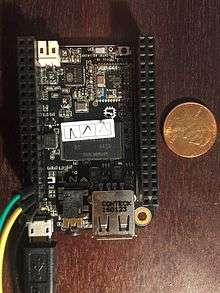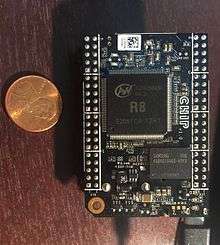CHIP (computer)
|
| |
| Release date | May 31, 2016[1] |
|---|---|
| Introductory price | US$9[2] |
| Operating system | Linux (Debian)[3][4] |
| CPU | 1 GHz R8[5] |
| Memory | 512 MB DDR3 SDRAM[3] |
| Storage | 4 GB onboard[3] |
| Power | 5 V DC >500 mA, wired or optional battery[2] |
CHIP (stylised as C.H.I.P.) is a personal single-board computer created by Next Thing Co., released on Kickstarter.[6][7] It is advertised as "the world's first $9 computer".
Since its alpha release, CHIP has gained community support. On Next Thing's forum of more than 5,000 users, more than 200 messages per month are about the board, another 200 are about related hardware.[8]
Milestones

NextThing began shipping alpha boards to so-called "Kernel Hacker" backers in late September 2015.[9] First customer ship (for Kickstarter backers) began by May 31, 2016.[1] In addition, NexThing has opened pre-order since December 2015.[10]
Models
A few months after NextThing released the original C.H.I.P board, it announced that it would release SiP board called CHIP Pro, targeting industrial and mass production.[11]
C.H.I.P
This is the original board, mostly targeting hobbyists and developers. The system is built around the SoC processor R8 from AllWinner as its core, which integrates an ARM CortexTM-A8 CPU (based on ARM architecture V7-A) and peripherals, such as Graphic Engine, UART, SPI, USB port, CIR, CMOS Sensor Interface and LCD controller.[12] The CPU is also accompanied with NEON SIMD coprocessor and has RCT JAVA-Accelerations to optimize Just-in-time (JIT) and dynamic adaptive compilation (DAC).
Features implemented on this model:
- Built in Wi-Fi B/G/N, Bluetooth 4.0
- Full USB port and USB On-The-Go port
- Composite video and stereo audio port via mini TRRS
- Optional composite TRRS to RCA audio-video cable
- Optional VGA adapter and HDMI adapter
- Open source hardware[13] and open source software[3]
- Up to 45 GPIO ports[14][15]
- HPI and API to develop add-ons boards called "DIP" [16]
- Supports 1-Wire and I2C protocols, PWM output
- Serial console and Ethernet via USB for quick headless operation[17]
- Can be powered by battery
- Onboard storage, pre-installed Linux OS (Debian)[3]
- Web-based firmware update[18]
C.H.I.P Pro
CHIP Pro is similar to the original CHIP board, but uses the newer version of the chip called GR8. GR8 is a System in Package (SiP) that features a 1 GHz Allwinner R8 ARMv7 Cortex-A8 processor with NEON SIMD extensions and a Mali-400 GPU. 256 MB of Nanya DDR3 SDRAM is combined with the R8 SoC into a 14mm x 14mm, 0.8mm pitch 252 ball FBGA package, simplifying the routing of connections. Instead of having two dual-line 40-pin sockets as on CHIP, it implements castellated edges where the pin holes are designed and optimized to embed to another board with SMT.[11] Most of the CHIP's hardware features are also included in this model.
Related hardware
Pocket C.H.I.P. and Pockulus
NextThing offers a case with a built-in screen and keyboard and a 5 hour battery called the Pocket C.H.I.P. The C.H.I.P. snaps into the case with no "screws or glues" creating a truly portable computer. On the lower right corner of the Pocket C.H.I.P. is a hexagonal hole that takes a standard #2 HB pencil. Inserting the pencil creates a stand that allows the Pocket C.H.I.P. to stand upright on a desk. Likewise, on the lower left is a circular hole for a pen. The Pockulus is a virtual reality setup that requires some 3d printing.
The C.H.I.P. as a game console

The Pico-8, Lexaloffle's fantasy console for 8-bit-style games, allows the C.H.I.P. to function as a game console. Code, music, sound and sprites can be altered at will.
External links
References
- 1 2 Next Thing (2016-05-31). "HOLY C.H.I.P.!!! Final Kickstarter Fulfillment Has Begun!!!". Kickstarter. Retrieved 14 September 2016.
- 1 2 Next Thing. "CHIP - The World's First Nine Dollar Computer". Kickstarter. Retrieved 11 October 2015.
- 1 2 3 4 5 Raymond Wong (2015-05-07). "C.H.I.P. — the super tiny computer that only costs $9". Mashable.com. Retrieved 2016-07-16.
- ↑ "$9 Debian-Based C.H.I.P. Computer Is a Kickstarter Smash | Developers". LinuxInsider. Retrieved 2016-07-16.
- ↑ Next Thing (2016-06-23). "The World's First Nine Dollar Computer". Next Thing, Co. Retrieved 2016-07-16.
- ↑ Next Thing (2016-06-23). "Get C.H.I.P. - The World's First Nine Dollar Computer". Nextthing.co. Retrieved 2016-07-16.
- ↑ John Patrick Pullen (2015-05-14). "C.H.I.P Could Be the World's Cheapest Computer". Time.com. Retrieved 2016-07-16.
- ↑ "Next Thing Forum". Next Thing. Retrieved 14 September 2016.
- ↑ Next Thing (2015-09-24). "Holy Ship! Alpha Ships Have C.H.I.P.ped!!!". Kickstarter. Retrieved 14 September 2016.
- ↑ Next Thing (2015-11-30). "The Clear Case for C.H.I.P. (also pre-orders are open)". Kickstarter. Retrieved 14 September 2016.
- 1 2 Co., Next Thing. "Get C.H.I.P. and C.H.I.P. Pro - The Smarter Way to Build Smart Things". getchip.com. Retrieved 2016-10-30.
- ↑ "NextThingCo/CHIP-Hardware" (PDF). GitHub. Retrieved 2016-10-30.
- ↑ Next Thing. "Open Source Hardware: Where To Get It". Retrieved 24 September 2016.
- ↑ David Scheltema (2015-11-28). "C.H.I.P. vs Pi Zero: Which Sub-$10 Computer Is Better?". Makezine. Retrieved 14 September 2016.
- ↑ Next Thing. "Expanding GPIO". Retrieved 14 September 2016.
- ↑ Next Thing. "DIP Specifications". Retrieved 24 September 2016.
- ↑ Next Thing. "CHIP OS 4.4 Released [VGA, HDMI, and more!]". Retrieved 14 September 2016.
- ↑ Next Thing. "Flash C.H.I.P. from your Web Browser - So Shiny! So Chrome!". Kickstarter. Retrieved 14 September 2016.